[1]
D.A. Anderson, D.W. Christoensen, H.U. Bahia, et al., SHRP-F-369 Binder Characterization and Evaluation. Vol. 3. Physical Characterization, Washington, DC, (1994).
Google Scholar
[2]
S.I. Dubina, V.G. Kandrashin, The Quality of Russian Highways, Transport of the Russian Federation. 2 (2006) 49-50.
Google Scholar
[3]
EN 12593:2015 Bitumen and Bituminous Binders. Determination of the Fraass Breaking Point.
DOI: 10.3403/30138272
Google Scholar
[4]
P. Radziszewski, M. Sarnowski, J. Król, P.et al., Low Temperature Requirements for Bitumen in Central East European Road Construction, The Baltic Journal of Road and Bridge Engineering. 14 (2) (2019) 249–270.
DOI: 10.7250/bjrbe.2019-14.442
Google Scholar
[5]
J. D'Angelo et al, Revision of the Superpave High Temperature Binder Specification: The Multiple Stress Creep Recovery Test, Journal of the Association of Asphalt Paving Technologists. 76 (2007) 123-162.
Google Scholar
[6]
E.A. Romasyuk, Dorozhnye Asfal'topolimerbetony s Kompleksno-Modificirovannoj Strukturoj Povyshennoj Ustalostnoj Dolgovechnosti. Diss. kand. tekhn. nauk [Road Asphalt-polymer Concrete with a Complex-modified Structure of Increased Fatigue Life. Ph.D. Tesis]. Makeevka, (2015).
Google Scholar
[7]
V. A. Zolotarev, Dolgovechnost' dorozhnyh asfal'tobetonov [Durability of Road Asphalt Concrete], V. N. Karazin Kharkiv National University, (1977).
Google Scholar
[8]
Polymer Modified Bitumen, Woodhead Publishing, Cambridge, UK, (2011).
Google Scholar
[9]
M. Porto, P. Caputo, V. Loise, et al., Bitumen and Bitumen Modification: A Review on Latest Advances, Appl. Sci. 9 (4) (2019) 742.
DOI: 10.3390/app9040742
Google Scholar
[10]
H. L. Von Quintus, J. Mallela, M. Buncher, Quantification of Effect of Polymer-Modified Asphalt on Flexible Pavement Performance, Journal of Transportation Research Board. 2001 (2007) 141-154.
DOI: 10.3141/2001-16
Google Scholar
[11]
D. Lesueur, The Colloidal Structure of Bitumen: Consequences on the Rheology and on the Mechanisms of Bitumen Modification, Advances in Colloid and Interface Science. 145 (2009) 42-82.
DOI: 10.1016/j.cis.2008.08.011
Google Scholar
[12]
AASHTO T 313 Determining the Flexural Creep Stiffness of Asphalt Binder Using the Bending Beam Rheometer (BBR). (2019).
DOI: 10.1520/d6648-08r16
Google Scholar
[13]
AASHTO TP 92-14 Determining the Cracking Temperature of Asphalt Binder Using the Asphalt Binder Cracking Device (ABCD). (2018).
Google Scholar
[14]
M. Farrar, Technical White Paper. Determining the Low-Temperature Rheological Properties of Asphalt Binder Using a Dynamic Shear Rheometer (DSR). Fundamental Properties of Asphalts and Modified Asphalts III Product, FP 08 March, (2015).
DOI: 10.1520/d7175-05
Google Scholar
[15]
E. Jellema, E. Scholten, S. De Vries, et al. Comparing Cold Performance Results Using Fracture Toughness Test, Asphalt Binder Cracking Device, Fraass Breaking Point and Bending Beam Rheometer, 5th Eurasphalt & Eurobitume Congress, 13-15th June 2012, Istanbul.
Google Scholar
[16]
Sorokin, A.V., et al., Patent RF 2612637 (2017).
Google Scholar
[17]
A.A. Berlin, V.G. Nikolskii, I.A. Krasotkina, et al., Problems of Effectiveness Evaluation of Modifiers Introduced into Asphalt Concrete Mixtures According to «Russian Dry Process», Vse Materialy. Entsiklopedicheskii Spravochnick, 2 (2021) 2-9.
Google Scholar
[18]
AASHTO T 240-13 Standard Method of Test for Effect of Heat and Air on a Moving Film of Asphalt (Rolling Thin-Film Oven Test). (2017).
DOI: 10.1520/d2872
Google Scholar
[19]
N.I. Chekunaev, A.M. Kaplan, On Increase of Strength and Fatigue Life of Asphalt Composites by Introducing Ultra-Small Particles of Elastomers, Procedia Materials Science, 3, 2014, p.698–705.
DOI: 10.1016/j.mspro.2014.06.115
Google Scholar
[20]
V. Gordeeva, Yu. A. Naumova, V. G. Nikol'skii, et al., Analysis of Flow Curves of Modified Bitumen Composites, Polymer Science. Series D. 13 (2) (2020) 151–156.
DOI: 10.1134/s1995421220020094
Google Scholar
[21]
AASHTO R 28-12 Accelerated Aging of Asphalt Binder Using a Pressure Aging Vessel (PAV). (2016).
Google Scholar
[22]
V.N. Gorbatova, I.V. Gordeeva, T.V. Dudareva, et al., Rheological Properties of Bitumen with Powder Rubber Modifier Obtained by High-Temperature Shear Grinding. In: Vatin N. (eds.) Proceedings of EECE 2020. Lecture Notes in Civil Engineering. 150 (2021) 475-485.
DOI: 10.1007/978-3-030-72404-7_46
Google Scholar


